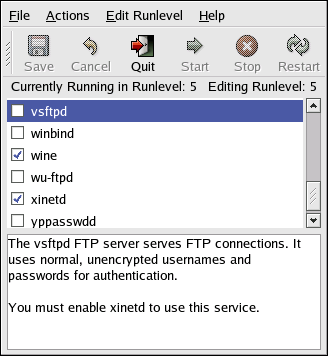Available Network Services
While user access to administrative controls is an important issue for system administrators within an organization, keeping tabs on which network services is of paramount importance to anyone who installs and operates a Linux system.
Many services under Linux behave as network servers. If a network service is running on a machine, then a server application called a daemon is listening for connections on one or more network ports. Each of these servers should be treated as potential avenue of attack.
Risks To Services
Network services can pose many risks for Linux systems. Below is a list of some of the primary issues:
Buffer Overflow Attacks — Services which connect to ports number 0 through 1023 must run as an administrative user. If the application has an exploitable buffer overflow, an attacker could gain access to the system as the user running the daemon. Because exploitable buffer overflows exist, crackers will use automated tools to identify systems with vulnerabilities and once they have gained access, they will use automated rootkits to maintain their access to the system.
Denial of Service Attacks (DoS) — By flooding a service with requests, a denial of service attack can bring a system to a screeching halt as it tries to log and answer each request.
Script Vulnerability Attacks — If a server is using scripts to execute server-side actions, as Web servers commonly do, a cracker can mount an attack improperly written scripts. These script vulnerability attacks could lead to a buffer overflow condition or allow the attacker to alter files on the system.
To limit exposure to attacks over the network all services that are unused should be turned off.
Identifying and Configuring Services
To enhance security, most network services installed with Red Hat Linux are turned off by default. There are, however some notable exceptions:
lpd — A printer server, required by the lpr command.
portmap — A necessary component for the NFS, NIS, and other RFC protocols.
xinetd — A super server that controls connections to a host of subordinate servers, such as wu-ftpd, vsftpd, telnet, and sgi-fam (which is necessary for the Nautilus file manager).
sendmail — The Sendmail mail transport agent is enabled by default, but only listens for connections on the localhost.
sshd — The OpenSSH server, which is a secure replacement for Telnet.
When determining whether or not to leave these services running, it is best to use common sense and err on the side of caution. For instance, if you do not own a printer, do not leave lpd running with the assumption that one day you might buy one. The same is true for portmap. If you do not mount NFS volumes or use NIS (the ypbind service), then turn portmap should be disabled.
Red Hat Linux ships with three programs designed to switch services on or off. They are Services Configuration Tool, ntsysv, and chkconfig. For information on using these tools, see the chapter titled Controlling Access to Services in the Official Red Hat Linux Customization Guide.
If you are not sure what purpose a service has, the Services Configuration Tool has a description field, illustrated in Figure 4-3, that may be of some use.
But checking to see which network services are configured to start at boot time is not enough. Good system administrators should also check which ports are open and listening. See the Section called Verifying Which Ports Are Listening in Chapter 5 for more on this subject.
Insecure Services
Potentially any network service is insecure. This is why turning unused services off is so important. Exploits for services are revealed and patched routinely. But you must remember the importance of keeping the packages associated with any given service updated. See for more on this issue.
Some network protocols are inherently more insecure than others. These include any services which do the following:
Pass Usernames and Passwords in Plain Text — Many older protocols, such as Telnet and FTP, do not encrypt the authentication session and should be avoided whenever possible.
Pass Sensitive Information in Plain Text — Protocols that pass the username and password in plain text also pass everything transfered between the server and client in plain text. These include Telnet, FTP, HTTP (httpd), and SMTP (sendmail).
Many network file systems, such as NFS and SMB, also pass information over the network in plain text. It is the user's responsibility when using these protocols to limit what type of data is transmitted.
Remote memory dump services, like netdump, pass the contents of memory over the network. Memory dumps can contain passwords or, even worse, database entries and other sensitive information.
Other services like finger and rwhod reveal information about users of the system.
Examples of inherently insecure services includes the following:
rlogin
rsh
telnet
vsftpd
wu-ftpd
All remote login and shell programs (rlogin, rsh, and telnet) should be avoided in favor of SSH. (see the Section called Security Enhanced Communication Tools for more information about sshd).
FTP is not as inherently dangerous to the security of the system as remote shells, but FTP servers must carefully configured and monitored to avoid problems.
Services which should be carefully implemented and behind a firewall include:
finger
identd
netdump
netdump-server
nfs
portmap
rwhod
sendmail
smb (Samba)
yppasswdd
ypserv
ypxfrd
The next section discusses tools available to set up a simple firewall.
